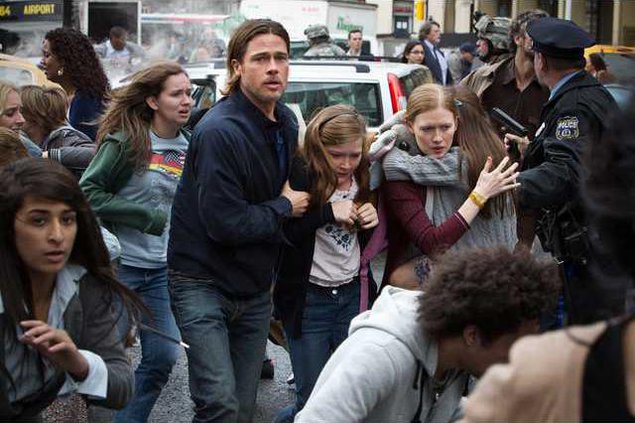“World War Z” was released in theaters on June 21, 2013. The zombie apocalypse film, based on the book of the same name by Max Brooks, went on to gross over $200 million domestically and ranked as the 13th highest-grossing film of 2013.
When the DVD and Blu-ray versions of the film were released in September, consumers had their choice between the theatrical version, rated PG-13, and an unrated version “with intense footage not shown in theaters,” according to the film’s website.
In an interview with the website shocktillyoudrop.com about the DVD and Blu-ray release, director Marc Forster said, “I’m really excited for (audiences) to check out the unrated version because, obviously, when you’re trying to deliver a PG-13 you’re a little bit handcuffed. … The unrated version is my preference because it’s not just about blood and gore being added. The overall intensity is more than the rated version. You can dial it up more.”
Unrated DVD and Blu-rays add a new wrinkle for content-conscious viewers who take movie ratings seriously. These versions of films became popular in the late 1990s, according to a 2005 article by Elaine Dutka in the Los Angeles Times.
Unrated versions can include scenes of violence, sex, nudity or profanity that weren’t shown in theaters. However, that's not always the case.
“An unrated film is simply that — a version of the movie that has not been submitted for a rating,” said Kate Bedingfield, chief spokeswoman for the Motion Picture Association of America. “The ratings system is voluntary, so anyone can release an unrated film in the home entertainment market. However, if a film has already been rated and the filmmaker releases an unrated version on DVD or Blu-ray, the packaging of the unrated version must include a heads-up for parents that states what the original version of the film was rated and notes that the unrated version includes different material.”
Because unrated DVDs and Blu-rays are becoming more popular — even Netflix has unrated films in its library — parents may want to pay attention to whether the film they are watching at home is the same shown in theaters.
According to former Deseret News film critic Chris Hicks, who continues to write columns and articles about DVDs for the publication, there are three basic reasons for the "unrated" label.
First, the movie simply has extra scenes not shown in theaters that, while not necessarily objectionable, were not rated by the MPAA and therefore must be considered unrated.
“The thing about the movie rating system is every time you change the movie, however you adjust it, it has to be rated again,” Hicks said. “It can’t go on with the previous rating if it’s been changed. So, they may just not be bothering to rate it again. It may not be any more harsh than it already was before; it’s just different. They didn’t bother to rate it and it came out unrated.”
In some cases, according to Hicks, the studios don’t bother to get the movie rated again because of the expense. Ratings boards charge the studios a percentage of the movie's budget, and multiple ratings would eat up the profit. It is easier, therefore, to mark the DVD or Blu-ray "unrated" and not bother to pay to have the film receive another rating.
Bonus materials on DVDs and Blu-rays, such as deleted scenes or audio commentary by the actors or director of the film, are also part of this category.
On most DVD and Blu-ray cases — including family-friendly films such as Disney’s “Frozen” — wording such as “Bonus Material Not Rated” or “Special Features Not Rated” appears underneath the actual rating of the film.
The second reason a DVD or Blu-ray might be considered unrated is that the film was released prior to the MPAA rating system. If the film was recently rereleased on DVD or Blu-ray, it is likely that it has been given a modern rating. But it is possible to still find films with “Approved,” “Not Rated” or “Unrated” ratings.
Films such as “Mary Poppins” (1964) and “The Ten Commandments” (1956) were originally given an “Approved” rating, but with recent releases on DVD and Blu-ray, the rating was changed to “G.” However, films such as “Arsenic and Old Lace” (1944), “The Robe” (1953) and “Mr. Smith Goes to Washington” (1939), among others, still have an “NR” or, in some cases, a “UR” rating on the DVD.
The third reason is the one parents need to be aware of. Extra scenes added to the DVD or Blu-ray could very well include objectionable content such as sex, nudity, violence or profanity that was not featured in the theatrical version.
“There are two hard-and-fast reasons for why movies come out in an unrated version,” Hicks said. “One is that they had to tone it down to get whatever rating they wanted. Sometimes they had to tone down an NC-17 so they could get an R so it would show in most theaters. And sometimes they tone down an R-rated movie to get a PG-13 and then when they release it (on DVD) they want the version they originally made to go out and they justify it that way. … The other reason is just because they can. They have all of these deleted scenes they didn’t use in the film itself and it’s another way for the studio to make a little more money.”
The unrated versions are clearly labeled. However, unlike movies that are rated R, there aren’t many safeguards in place for retailers to keep unrated DVDs or Blu-rays from minors. Inevitably, the responsibility lies with the parents in determining what is suitable for their children.
“Our aim (at the MPAA) is to ensure that parents have the information they need to make viewing decisions on behalf of their kids,” Bedingfield said.
Ben Tullis is a freelance writer. Follow him on Twitter at bentullis.
What parents need to know about 'unrated' DVDs





